-
Don’t move immediately
Before you move, understand the move your opponent just made. Your opponent always has a reason behind his or her move. (You may decide that it’s a bad reason, but there’s always some reason.) Stop and figure it out. Don’t move immediately. Look at the position. Sit on your hands, if you have to! Say to yourself every time its your move:
-
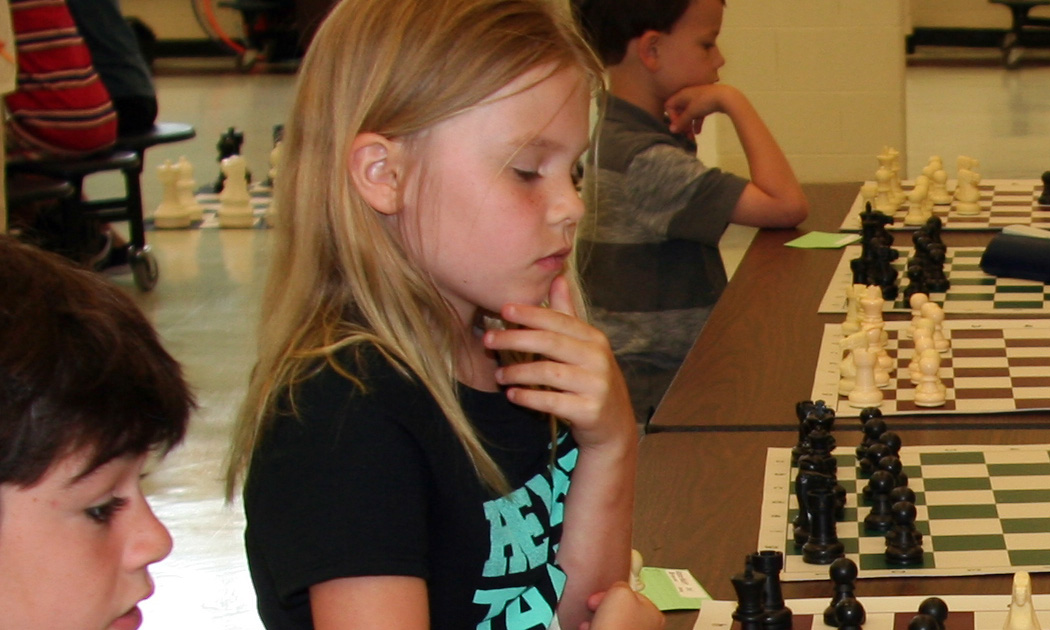
-
“Why did my opponent make that move?”
Well, very often, your opponent’s move attacks one or more of your pieces. If your piece is attacked, find how to protect it or move it out of the way. Remember the point values of the pieces when you look at the board.
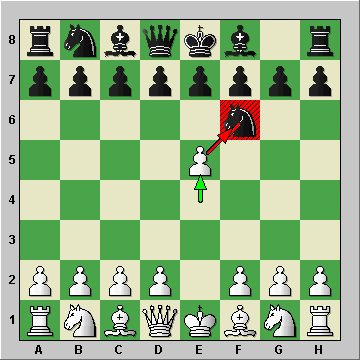 Look at this position. White has just moved his king-pawn from e4 to e5 and is directly attacking black’s knight. If your opponent attacks your 3-point knight with a 1-point pawn, well, MOVE IT! Don’t leave the knight sitting there and hope your opponent misses pawn takes knight. Don’t ever “hope” your opponent doesn’t do something, because whatever you’re “hoping” won’t happen is usually is exactly what happens! Remember, your opponent HAD A REASON for making that pawn move. (“Why did my opponent make that move?”) If your opponent moved his pawn attack your knight and you don’t do anything about it, then he’s going to take your knight with that pawn on the next move.
Look at this position. White has just moved his king-pawn from e4 to e5 and is directly attacking black’s knight. If your opponent attacks your 3-point knight with a 1-point pawn, well, MOVE IT! Don’t leave the knight sitting there and hope your opponent misses pawn takes knight. Don’t ever “hope” your opponent doesn’t do something, because whatever you’re “hoping” won’t happen is usually is exactly what happens! Remember, your opponent HAD A REASON for making that pawn move. (“Why did my opponent make that move?”) If your opponent moved his pawn attack your knight and you don’t do anything about it, then he’s going to take your knight with that pawn on the next move.“Why did my opponent make that move?”
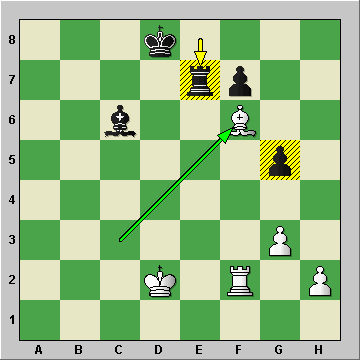
Sometimes when it’s your opponent’s move, however, he or she will just simply make a mistake and put a piece on a square where you can take it. (Hey, nobody’s perfect.) Look to see if you can take your opponent’s pieces. Consider, though, that just because you CAN capture one of your opponent’s pieces, it doesn’t mean you HAVE TO take it. There might be something better for you to do.
Consider this position as shown on the right. White moved his bishop to f6 and put black’s king in check. Black, for some reason, decided to move his rook into the path of the bishop to get out of check. (I guess black forgot that rooks, at 5 points each, are worth more than 3-point bishops.)
But does white HAVE to take the rook right away?
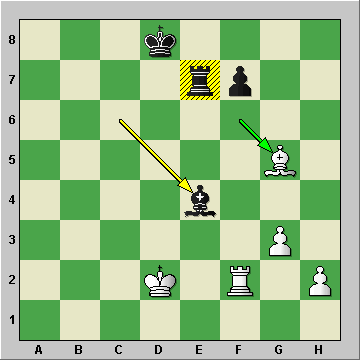 No, he doesn’t. As we see on the left here, he takes the pawn instead. Why? Because black’s rook isn’t going anywhere. It can’t. If black moved his rook in this position, he would expose his king to check, and that would be an illegal move. Therefore, black can’t move the rook. Black’s rook is ‘pinned’ against his king by white’s bishop. A pinned piece like this can’t move.
No, he doesn’t. As we see on the left here, he takes the pawn instead. Why? Because black’s rook isn’t going anywhere. It can’t. If black moved his rook in this position, he would expose his king to check, and that would be an illegal move. Therefore, black can’t move the rook. Black’s rook is ‘pinned’ against his king by white’s bishop. A pinned piece like this can’t move. So since the rook can’t move, white wisely goes ahead and picks up the free pawn. (“Free” is good.)
Black now moves his bishop to e4.
So is there any pressing reason that would compel white to take the rook right away? Yes, it’s still pinned. Yes, white can go ahead and play ‘bishop takes rook’. But what else might white do (maybe with his own rook) since the black rook STILL isn’t going anywhere. Think about it…..
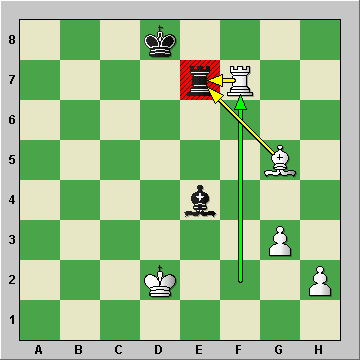 YES! Looking at the diagram to the right, white moves HIS rook from f2 to f7 and takes the remaining black pawn. (We would write that move down as ‘Rxf7’.)
YES! Looking at the diagram to the right, white moves HIS rook from f2 to f7 and takes the remaining black pawn. (We would write that move down as ‘Rxf7’.) Here’s why white took the pawn:
- Black’s rook was still pinned against his king, so it still wasn’t going anywhere;
- Black’s pawn on ‘f7’ wasn’t guarded by any other black piece. It wasn’t guarded by the black rook, which is still pinned against the king by white’s bishop! It was sitting there free to grab, which white did.
Most importantly, though, by playing ‘Rxf7’, White now has TWO pieces attacking the rook. Yes, white could have just taken the black rook with his bishop, at which point black would have played ‘Kxe7’. White would have had black’s 5-point rook, and black would have had white’s 3-point bishop. It would have been a good deal for white. (We call that ‘winning the exchange’.)
But this is a better deal! Regardless of what black does now, white is going to play ‘rook takes rook’ the next move, and black WILL NOT BE ABLE TO RECAPTURE with his king because the rook will be protected by the white bishop, and that would be moving into check! Black just has to sit there and watch his rook disappear and there’s nothing he can do about it. White has ‘won’ black’s rook (plus a couple of pawns to boot!) and it hasn’t cost white one bit of material.
Set the position up yourself and play with it. Try it both ways and see what the differences are.
Think, even though it takes some time. Chess is very complicated, and there are thousands of possibilities on the chess board. Nobody sees everything and makes good moves if they move too fast. Not you, not me, not even international grandmasters like Gary Kasparov or Bobby Fischer. If you spend more time thinking than your opponent, you will have a greater chance of winning then they do. Speed causes mistakes, and the person who makes the fewest mistakes usually wins in chess.
So, to go over it again:
- Think, even though it takes time
- If your opponent attacks one of your pieces with something of lesser value, move it out of the way
- If your opponent leaves one of his pieces ‘hanging’, take it, unless there’s something more profitable to do
- And above all else, every time your opponent moves, ask yourself:
“Why did my opponent make that move?”
If you do, you’ll be well on your way to becoming a GOOD chess player!
